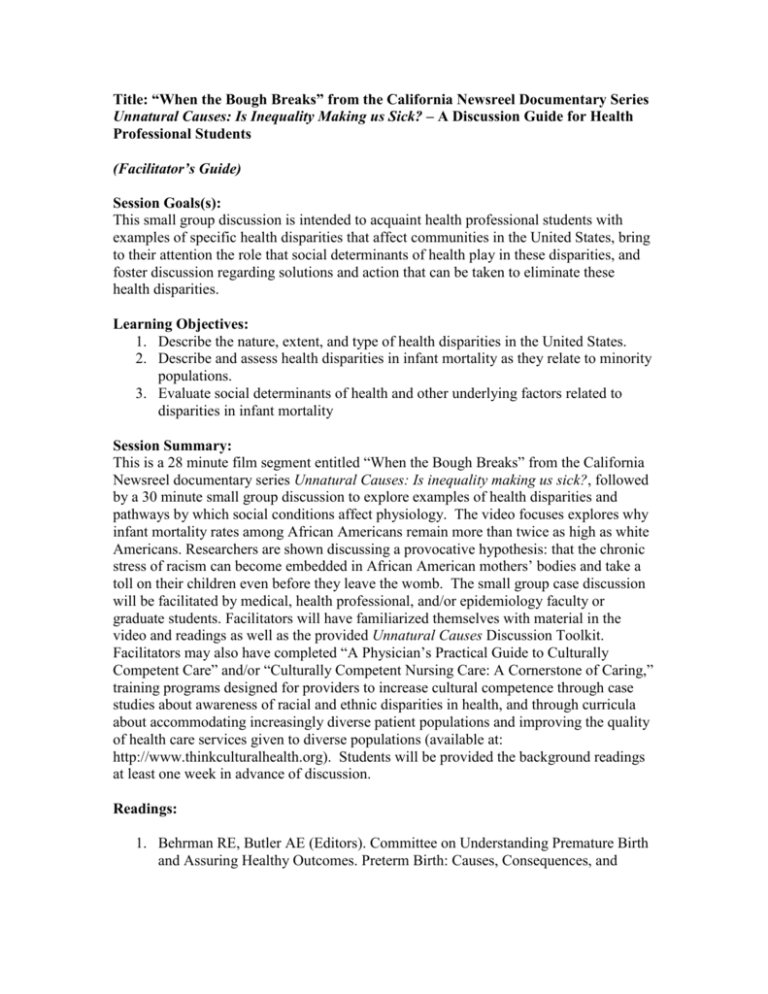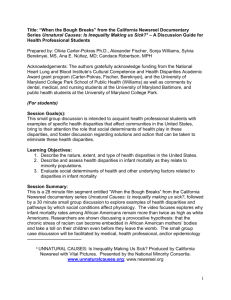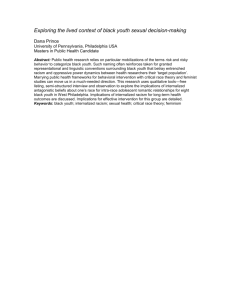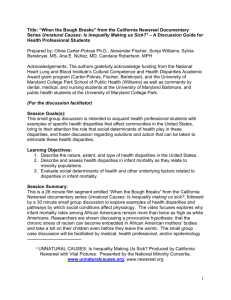Unnatural Causes Whe.. - National Consortium for Multicultural
advertisement

Title: “When the Bough Breaks” from the California Newsreel Documentary Series Unnatural Causes: Is Inequality Making us Sick? – A Discussion Guide for Health Professional Students (Facilitator’s Guide) Session Goals(s): This small group discussion is intended to acquaint health professional students with examples of specific health disparities that affect communities in the United States, bring to their attention the role that social determinants of health play in these disparities, and foster discussion regarding solutions and action that can be taken to eliminate these health disparities. Learning Objectives: 1. Describe the nature, extent, and type of health disparities in the United States. 2. Describe and assess health disparities in infant mortality as they relate to minority populations. 3. Evaluate social determinants of health and other underlying factors related to disparities in infant mortality Session Summary: This is a 28 minute film segment entitled “When the Bough Breaks” from the California Newsreel documentary series Unnatural Causes: Is inequality making us sick?, followed by a 30 minute small group discussion to explore examples of health disparities and pathways by which social conditions affect physiology. The video focuses explores why infant mortality rates among African Americans remain more than twice as high as white Americans. Researchers are shown discussing a provocative hypothesis: that the chronic stress of racism can become embedded in African American mothers’ bodies and take a toll on their children even before they leave the womb. The small group case discussion will be facilitated by medical, health professional, and/or epidemiology faculty or graduate students. Facilitators will have familiarized themselves with material in the video and readings as well as the provided Unnatural Causes Discussion Toolkit. Facilitators may also have completed “A Physician’s Practical Guide to Culturally Competent Care” and/or “Culturally Competent Nursing Care: A Cornerstone of Caring,” training programs designed for providers to increase cultural competence through case studies about awareness of racial and ethnic disparities in health, and through curricula about accommodating increasingly diverse patient populations and improving the quality of health care services given to diverse populations (available at: http://www.thinkculturalhealth.org). Students will be provided the background readings at least one week in advance of discussion. Readings: 1. Behrman RE, Butler AE (Editors). Committee on Understanding Premature Birth and Assuring Healthy Outcomes. Preterm Birth: Causes, Consequences, and Prevention. National Academy of Sciences. 2007. Available at: http://www.nap.edu/catalog.php?record_id=11622#toc 2. Jackson FM. Race, Stress, and Social Support: Addressing the Crisis in Black Infant Mortality. Joint Center for Political and Economic Studies. September 2007. 3. David R, Collins J. Disparities in Infant Mortality: What’s Genetics Got to Do With It? American Journal of Public Health 2007;97(7):1191-1197. 4. Lu MC, Halfon N. Racial and Ethnic Disparities in Birth Outcomes: A LifeCourse Perspective. Maternal and Child Health Journal 2003; 7(1): 13-30. Additional information on trends over time in disparities in infant mortality: 5. Alexander G, Wingate M, Bader D, Kogan M. The increasing racial disparity in infant mortality rates: Composition and contributors to recent US trends. American Journal of Obstetrics and Gynecology. 2008;198(1):51.e1-51.e9 6. Harper S, Lynch J, Burris S, Davey Smith G. Trends in the Black-White Life Expectancy Gap in the United States, 1983-2003. JAMA. 2007;297:1224-1232. Available at: http://jama.ama-assn.org/cgi/reprint/297/11/1224 Discussion Questions: 1. High infant mortality rates are a major problem for the United States, with America ranking 34th internationally, below even third world countries. Why is that? What can we do to change this? 2. What are the factors that the video explores to explain why African-American women have low birth weight babies at twice the rate of white women? Can you think of possible contributing factors? 3. The film looks at long-term stress caused by social tensions such as racism, and the effects this stress has on the body. Substantial social changes are needed to target overcoming the roots of racism, and to disrupt those social tensions caused by racism. Society needs to do a better job as a whole talking about racism, recognizing now that it has a negative physical impact on health and working to prevent it. The video rules out such factors as socioeconomic status, education, and genetics. The video explores racism as a major additional stressor in life and the body’s reaction to racism over the course of the lifetime. Studies showed that women who thought that they had been treated unfairly due to racism had twice the risk of low birth weight children. Stress comes from a number of different areas, but the stress from racism is an add-on. The video mentions that rates of infant mortality in African-American women with a college degree are higher than rates in white women without a high school diploma. What can we attribute that to? 4. Are certain racial groups predisposed genetically to low birth weight babies or premature deliveries? The study mentioned in the video suggests not. What do you think? How can we account for this? 5. The study found that African immigrants to the United States and white Americans had children of comparable birth weights, whereas AfricanAmericans had children with significantly lower birth weights. The study also found that African immigrants to the United States needed just one generation before their daughters were at risk for having premature babies at significantly higher rates and with poorer birth outcomes. This study suggests that the disparity of low birth weight children does not fall along racial lines, but that it is driven by some social determinant that AfricanAmerican women experience throughout their entire lives. During the 1960s and 70s with the civil rights and anti-poverty movements, health outcomes improved among African Americans compared to whites, including slowly lowering infant mortality rates. What has happened since then and why? 6. While education is a good predictor of infant mortality and low birth weight children within a given race (the higher the education, the higher the likelihood of a healthy weight baby), there is a great discrepancy across races. We must therefore look past education as the reason for this inequity. The video looks at the stress caused by racism over the mother’s whole life as the most likely explanation to this difference in likelihood of having a low birth weight child resulting in a greater risk of infant mortality between African-American women and white women. Possible Discussion Probes: o Can we attribute these statistics to health care providers not providing adequate care or referrals to African Americans? o A recent study found that if black mothers of very low birth weight babies gave birth at the same New York hospitals as white mothers of very low birth weight babies, the disparity of infant mortality between black and white babies would be reduced by more than one-third (Howell 2008). What does this tell us about health care provided? What can be done to elicit change? The gap began to widen again between the health of blacks and whites. The black to white infant mortality ratio began to climb and continues to climb today. In the 1980s, economic growth stagnated and the government began to cut back on social programs, resulting in the reversal of the progress made to give blacks the equal opportunities, in the form of government initiatives for integrated hospitals, better education opportunities, jobs, and housing. What is the phenomenon of living as a “life long minority”? Do you think this is a relevant issue? How do you think it affects overall quality of life? 7. Does racism take a toll on the body? How might racism do this? 8. The “Life-Course Perspective” deals with the idea that stress, regardless of race, not necessarily during pregnancy, but throughout the entire life can greatly determine the health of the baby. The video offers some biological explanations: o Stress hormones can reach a certain level quicker if the body is already full of stress hormones, causing premature delivery. o Stress could constrict blood flow to the placenta, which could limit fetal growth and lead to premature delivery. o Chronic stress may contribute to serious inflammation inside the uterus, which can trigger premature labor. Now there is some evidence that racism as a stressor does affect health outcomes, how can we further study it? 10. When confronted with racism, in addition to the psychological response, there is also a reaction from the body. If that body reaction is constant from repeated acts of racism or unfair treatment, it can easily take a heavy toll on the body. Dr. Camara P. Jones says the stressors of racism parallel gunning the engine of a car 24/7, wearing it out. What is the “Life-Course Perspective” that Dr. Lu refers to? How does it relate to women and the children they give birth to? 9. Living as a “life long minority” is dealing with an increased risk of racism. Stress caused by racism can have a lifelong impact on family and health. “Life long minority” status can cause chronic stress, which can build up in the body and wear it out. Racism is not a problem of the past. It is still present as a societal level problem, institutionalized, and part of our educational system, media, and culture. As Dr. Fleda Jackson has been studying, we must first talk to AfricanAmerican women. How are they affected by racism as a stressor psychologically and how does this translate into physical health outcomes? Are there African-American women that do not feel that they have been treated unfairly due to racism? How does their infant health compare? We must look at ways to provide support to women through these situations and feelings from an early age. Dr. Fleda Jackson, Dr. Mona Phillips, and Dr. Carol Hogue have started work in trying to study the effects of racism on African-American women. How will their studies be able to help women in the African-American communities? 11. How do you feel about this theory of racism being a major stressor on AfricanAmerican women and its effects on their pregnancies? Did the video show any innovative methods for fixing the problem? What if anything can be done about it? 12. Their studies have brought about focus groups, and developed a gendered measure of the effects of stressors. Their studies look at stressors faced by African-American women, such as if mothers need to take children outside of neighborhoods for the best educational opportunities, if they have concerns about racial profiling of their children, and if they have concerns about the opportunities they will have. These studies should yield information on how stress from racism affects African-American women, so that proper support can be provided, and necessary change can be enacted. One initiative mentioned in the video was the Family Health and Birth Center in Washington, D.C., which provides family support, employment, financial counseling, and prenatal care. The result of this support from the Family Health and Birth Center was that preterm births were reduced by one-third, and low birth weight deliveries cut in half. How can we as future health care professionals fix this apparent problem? There needs to be work to effect social policy changes. There needs to be work to provide support for women, especially minority groups, as such support has already proven effective, as in the case of the Family Health and Birth Center in Washington, D.C. We need to make it public that the effects of racism can cause negative health outcomes, so that people will become more aware of themselves. We need to start education from an early age in the school systems, to make sure curricula cover people of significance of all races, ethnicities, and cultures, so that no background is devalued from lack of recognition. E. A. Howell, P. Hebert, S. Chatterjee et al., Black/White Differences in Very Low Birth Weight Neonatal Mortality Rates Among New York City Hospitals, Pediatrics, March 2008 121(3):e407-e415.









